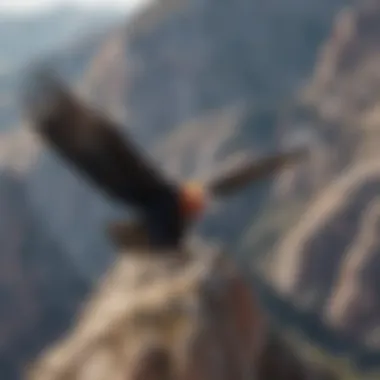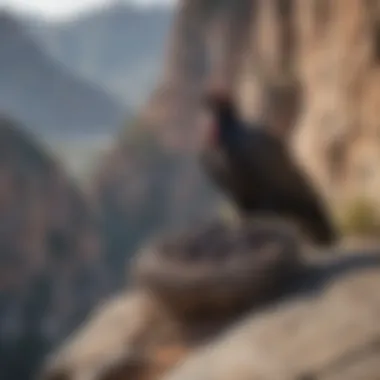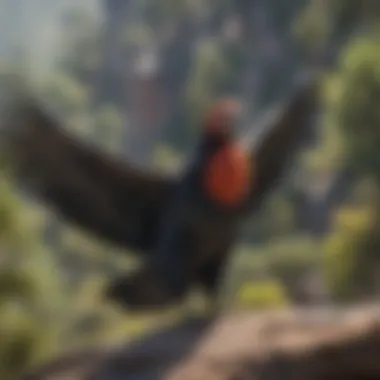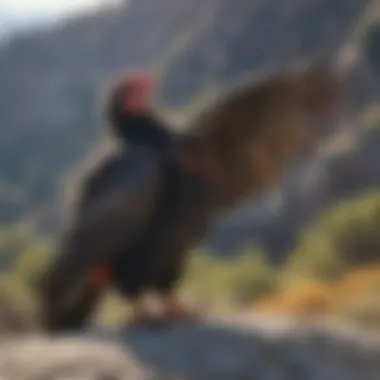Exploring the Habitat of the California Condor


Intro
The California condor, Gymnogyps californianus, represents a remarkable success story in wildlife conservation, yet its future remains at risk. Exploring its habitat reveals essential information about the ecological requirements and conservation efforts that impact its survival. Understanding where this majestic bird lives can guide actions aimed at preserving its remaining populations. The focus of this article is to delve into the unique environment required by the California condor and the challenges it faces due to human activities and environmental changes.
Fascinating Facts About the Animal
Unique Characteristics
The California condor is the largest land bird in North America, featuring a wingspan that can reach up to 10 feet. Its distinctive appearance includes a bald head, which helps keep it clean as it feeds on carcasses. The bird is primarily black, with striking white arm feathers; this contrast becomes even more pronounced in males during the breeding season.
Though known for their size, California condors also exhibit a long lifespan, often living up to 60 years in the wild. They reach sexual maturity around the age of 5 to 7 years, which affects their population growth.
Extraordinary Abilities
California condors are known for their exceptional flying ability. They can soar to heights over 15,000 feet and glide for long distances without flapping their wings, making them energy-efficient travelers. Their keen eyesight enables them to spot carcasses from great distances, essential for their scavenging lifestyle. This adaptability allows them to navigate a wide range of habitats.
Behavior and Habitat
Natural Habitats
California condors typically inhabit mountainous regions, open grasslands, and coastal areas of the West Coast, particularly in California, Arizona, and Utah. These environments provide necessary resources, such as nesting cliffs and abundant food sources. Their nesting sites are often found on steep cliffs or in tree cavities, where they can shelter eggs from predators and harsh weather.
Social Structures
Condors are social birds, often observed in groups. They engage in various social behaviors, including preening and communal roosting. This social structure is essential for their survival, as it helps in finding food and ensuring their breeding success. Young condors learn survival skills from older, more experienced birds, emphasizing the importance of community.
Recent Scientific Discoveries
Latest Research Findings
Ongoing research has revealed critical insights into the foraging patterns and habitat preferences of California condors. Scientists have tracked these birds using GPS technology to monitor their movements and identify areas that are vital for their survival. This information is vital for informing habitat protection efforts.
Breakthroughs in Animal Biology
Studies have also focused on the impact of lead poisoning, which remains a threat to the California condor population. Understanding the biological effects of lead ingestion has led to initiatives aimed at reducing lead ammunition use in environments where condors forage. This knowledge is assisting in the development of conservation strategies to enhance their chances of survival.
Cultural Significance
Animals in Folklore
The California condor has held various roles in different cultures. Native American tribes regard this bird as a symbol of renewal and strength. Folklore often portrays the condor as a guardian of the skies, reflecting its majestic presence and role in the ecosystem.
Influence on Art and Literature
In art, the California condor has inspired many artists and writers who use it as a symbol of conservation and the delicate balance of nature. Its image resonates in discussions around environmental preservation and the importance of safeguarding endangered species. This influence is pivotal in raising awareness about the threats faced by this incredible bird and the efforts needed to ensure its survival.
In summary, the California condor’s distinct characteristics, social structures, and the cultural significance it holds underscore the urgency of conservation efforts to protect its habitat and ensure its future.
Prelims to the California Condor
The California condor stands as a testament to the resilience of nature and the importance of conservation efforts. This section delves into the essential aspects of this majestic bird, providing insights that underscore the significance of understanding its habitat and survival. By focusing on the California condor, we can appreciate not only the beauty of this species but also the broader implications of its conservation for ecological balance and biodiversity.
Overview of the Species


The California condor (Gymnogyps californianus) is the largest bird in North America, notable for its impressive wingspan that can reach up to ten feet. These birds are characterized by their black plumage, contrasting white wing linings, and a distinct fleshy crown on their heads.
Historically, the population of California condors was widespread across the United States, extending from the Pacific Coast to the Appalachian Mountains. However, due to habitat destruction, poaching, and lead poisoning, the species became critically endangered. By 1987, only 27 individuals were left, prompting an urgent captive breeding program. Today, thanks to these efforts, the population has seen some recovery, although the California condor remains one of the world’s most endangered birds. Its survival hinges on conservation actions that not only protect these birds but also their habitats.
Significance in Ecosystems
California condors play a vital role in their ecosystems as scavengers. They help control the population of dead and decaying animals, which is crucial for maintaining healthy and balanced ecosystems. By consuming carrion, condors facilitate nutrient cycling and reduce the spread of disease. This function makes them essential to their habitats, as their presence indicates a healthy environment.
Furthermore, the conservation of the California condor has broader implications. Protecting this species fosters habitat preservation, which benefits many other organisms. Conservation efforts inspire communities to engage in programs that safeguard natural resources and promote environmental education, highlighting the interconnectedness of species within their ecosystems. The recovery of the California condor may symbolize hope for other endangered species facing similar threats.
Understanding the California condor’s role in nature emphasizes the necessity of conservation and habitat protection, not just for this species, but for the health of our ecosystems overall.
Geographical Distribution
Understanding the geographical distribution of the California condor is essential for grasping its habitat needs and conservation status. This section outlines both the historical and current ranges of the species, focusing on specific regional habitats that are crucial for its survival. By elucidating these elements, we can appreciate the dynamic landscape that California condors depend on, and the implications of their habitat preferences in the context of conservation efforts.
Historical Range
Historically, the California condor roamed across a vast expanse, from California to the Rocky Mountains and down into Mexico. Evidence shows that their range once included the coastal regions, the inland valleys, and even the arid deserts. A notable characteristic of this historical range is its diverse ecosystems, which provided varied food sources and suitable nesting sites. The slow decline of their population has closed off vast stretches of their once expansive habitat. Understanding this historical perspective is critical as it provides a benchmark for what has been lost and highlights the need for targeted conservation.
Current Range
Today, the California condor is primarily found in localized regions of Southern California, Arizona, Utah, and along the Central Coast of California. This current range is significantly smaller than its historical counterpart. The contraction of the range emphasizes the species' fragility and highlights the ongoing threats to its survival. With conservation efforts focused on these specific areas, understanding the current range becomes vital for effective management and successful recovery strategies.
Specific Regions of Habitat
Southern California
Southern California is a pivotal area for the California condor, as it has supported a small but vital population. The region's mountainous terrains and accessible food sources, like carrion, make it a suitable habitat. Key characteristics of this area include its diverse ecosystems, ranging from coastal regions to high mountain ranges. However, urban development poses significant challenges. This rapid expansion of human activity disrupts natural habitats and threatens the condor’s nesting success. Thus, preserving these habitats is critical for the ongoing survival of the species.
Arizona
Arizona serves as another essential habitat for the California condor, offering large expanses of uninhabited land. The key characteristic of Arizona is its vast wilderness areas, such as the Grand Canyon region, where condors can soar and find food without human interference. The unique features of this state include high cliffs and rugged forests, which provide natural roosting sites. However, environmental challenges such as drought can affect food availability, impacting the condor population in the region.
Utah
Utah is emerging as a significant area for the California condor due to ongoing conservation efforts. The state's high deserts and mountain ranges offer opportunities for nesting and foraging. A notable aspect of Utah is the rugged terrain, which provides natural protection against predators. As condors are released into the wild here, they adapt to new habitats, expanding their current range. However, the challenge remains to ensure ongoing support for these released birds, ensuring that their new habitats remain undisturbed.
Central Coast of California
The Central Coast of California plays a crucial role in the conservation of the California condor. This region includes unique ecosystems that support a variety of wildlife and offer plentiful food sources. The key aspect of this area is its diverse coastal environment, including cliffs and canyons that are ideal for nesting. A unique feature of this region lies in its blend of land and sea, providing a variety of habitats that are beneficial for feeding. Still, with human encroachment and tourism pressures, conserving these essential habitats presents ongoing challenges.
The California condor’s survival hinges on the preservation of its limited habitats amidst a backdrop of human encroachment and environmental change.
Preferred Habitat Characteristics
Understanding the preferred habitat characteristics of the California condor is crucial for ensuring its survival in the wild. These majestic birds require specific environmental conditions to thrive, and knowing their needs can help in conservation efforts. The interplay of various natural factors determines where these birds can nest and roost, which in turn affects their overall health and population stability.
Natural Geography
California condors are naturally drawn to rugged terrains that provide plenty of spaces for nesting and roosting. These birds often inhabit mountains, cliffs, and areas with vast open spaces. Their preference for natural geography influences their foraging behavior and nesting sites. Condors typically seek locations that are less disturbed by human activities, allowing them to live and hunt more effectively without fear.
The terrain can often include steep cliffs and ledges, providing both shelter and vantage points for spotting food. The natural geography also includes expansive grasslands and scrublands where condors can find carrion, their primary food source. By understanding these geographical preferences, conservationists can better protect areas that are essential for the condors' survival.
Altitude and Climate Preferences


The California condor thrives in elevations ranging from 2,000 to 6,000 feet. Their ability to soar at high altitudes allows them to glide effortlessly on thermals. This capability is essential in conserving energy while searching for food. The climate plays a significant role in their habitat choices. Condors prefer arid to semi-arid climates, where they can easily locate carrion without excessive vegetation obstructing their view.
The temperature is also a consideration. Too much humidity and rainfall can affect their nesting viability. Understanding these altitude and climate preferences helps wildlife managers maintain suitable habitats that can support healthy breeding populations.
Vegetation Types
The vegetation in the habitat of the California condor is diverse and affects their feeding strategies. These birds are typically found in areas with a mix of chaparral, grasslands, and scrub. These vegetation types contribute to the availability of food sources. Chaparral areas offer various small animals that may be prey to other species, but carrion remains their primary food source.
Grasslands provide open space that helps condors locate food from afar, while scrubland offers some shelter and nesting opportunities. The combination of these vegetation types creates an ecosystem that supports not only the condor but many other species as well. Preservation of these areas is vital for maintaining the delicate balance needed for the California condor's continued existence.
Nesting and Roosting
Nesting and roosting habits are vital aspects of California condor behavior, critical for understanding their survival and conservation. This section explains how these magnificent birds select nesting sites and their roosting habits, which play a significant role in their overall well-being and reproductive success.
Nesting Sites
California condors prefer to nest in locations that offer safety and seclusion. The birds often utilize rugged terrains such as cliffs or large trees, where there is minimal disturbance from predators and human activity. These natural features provide ample space for nesting, ensuring the young chicks can grow safely.
- Elevated Locations: Nesting sites need to be elevated to offer a good view and limit access to potential threats.
- Cavities and Hollows: Check for nests in natural cavities or hollows where eggs can remain secure from harsh weather and predators.
- Large Trees: When trees are used, they are typically large conifers, providing a stable place for nesting.
Successful nesting is crucial for the species, as each pair usually produces only one egg every other year. This low reproductive rate makes each nest vital for population recovery.
Roosting Habits
Roosting is equally important for condors, as it is where they rest and socialize. Condors will often choose roosting sites that are similar to nesting sites but may also prefer open areas where they can take flight easily.
- Selection of Roosting Spots: Roosting sites are typically on cliffs, trees, or high rocky outcrops. These spots help protect them from ground predators at night.
- Social Interaction: Condors are social birds and will often roost together in groups where they establish social hierarchies. This interaction is important for their mental health and social structure.
- Monitoring Behavior: Roosting habits can change based on the season and their environment. During food shortages, they may roost in closer proximity to food sources.
Proper nesting and roosting sites can significantly affect the breeding success of the California condor, impacting their future population growth.
In summary, nesting and roosting are two critical behaviors that inform us about the needs of California condors in the wild. Protecting these specific habitats ensures the survival of this critically endangered species. Understanding their preferences helps in conservation efforts, emphasizing the need for preserving these natural environments.
Impact of Human Activity
Human activity has a profound effect on ecosystems and the species that inhabit them. For the California condor, this impact can be both detrimental and sometimes beneficial, depending on the context. Understanding these influences is critical for devising effective conservation strategies.
Urban Development
Urbanization leads to the loss of natural habitats essential for the California condor's survival. As cities expand, they encroach on the territories where condors nest and roost. The conversion of land for housing, agriculture, and infrastructure often results in a fragmented landscape. This fragmentation reduces the availability of suitable nesting sites and interrupts the condors' migratory patterns.
While the condors are capable of soaring great distances, significant barriers such as roads and buildings disrupt their movement, making it challenging to find food and mates. Furthermore, increased human presence can lead to direct threats, including collisions with vehicles or power lines.
Efforts are underway to mitigate these impacts. Initiatives to conserve large stretches of land help maintain the habitats required for condors' survival. However, it remains imperative that urban planning considers wildlife corridors to allow the safe passage of these birds.
Environmental Rehabilitation Challenges
Upon recognizing the impact of human activities, various organizations emphasize the need for environmental rehabilitation programs. However, these efforts face many challenges. Restoring habitats that support the California condor involves significant investment and time. The previous degradation of ecosystems has left patches of land that no longer function as they once did.
One of the primary hurdles is the introduction of invasive species, which can compete for resources that condors rely on. For instance, non-native plants may alter the landscape in ways that food sources for condors become scarce. Also, chemical pollutants from agricultural practices risk contaminating the food web which condors depend on.
Furthermore, restoration projects often lack enough community involvement or public awareness. Educating local populations about the plight of the California condor and the importance of preserving their habitats is essential. Engaging communities not only fosters a sense of responsibility but also contributes to successful rehabilitation efforts.
As these challenges persist, the path toward restoring the California condor's habitat requires continuous research and adaptation of strategies. A combination of grassroots efforts and scientific advancements can help create environments more conducive to their survival.
"Conservation is a race against time; every action counts in ensuring the survival of endangered species like the California condor."
Conservation Efforts


Conservation efforts are vital in protecting the California condor. This majestic bird represents not only a species but also the delicate balance of the ecosystems it inhabits. The California condor is considered critically endangered, with only a small population remaining in the wild. Hence, ongoing conservation programs focus on various strategies to ensure the survival and recovery of this species.
Protected Areas
Protected areas play a crucial role in the conservation of the California condor. These designated regions provide essential habitats that are largely free from human interference. Key protected areas include:
- Channel Islands National Park: This park offers a secure nesting environment.
- Los Padres National Forest: The vast wilderness supports feeding grounds.
- San Gabriel Mountains National Monument: These mountains host suitable roosting sites.
The establishment of these protected areas has led to a gradual increase in the condor population. Not only do they provide safety, but they also allow for natural behaviors to be observed and fostered.
Captive Breeding Programs
Captive breeding programs are essential for augmenting the existing population of California condors. Established in the 1980s, these programs were initiated when the species' numbers dwindled to just twenty-two individuals. Key components of these programs include:
- Breeding in Controlled Environments: The birds are bred under human care, allowing for a controlled genetic diversity.
- Release Programs: Once mature, these birds are carefully reintroduced into their natural habitats.
- Monitoring: Released condors are tracked via radio transmitters and GPS to ensure their adaptation to the wild.
Successful captive breeding has seen numbers rise from near extinction to over 500 condors today, highlighting the significant impact of these efforts.
Community Involvement
Community involvement is another key aspect of California condor conservation. Engaging local communities fosters awareness and support for conservation initiatives. Important elements include:
- Educational Programs: Schools and local organizations educate the public about the condor’s plight and the role they play in their ecosystem.
- Volunteer Opportunities: Communities are encouraged to participate in habitat restoration and monitoring projects.
- Collaboration with Agencies: NGOs and governmental departments often partner to promote biodiversity and the significance of preserving native flora and fauna.
Through education and active participation, communities can contribute significantly to the California condor’s future.
These combined conservation efforts illustrate a multifaceted approach to protect and revive the California condor population. By safeguarding their habitat, supporting breeding programs, and involving communities, we can create a sustainable future for this iconic species.
Future of the California Condor
Understanding the future of the California condor is critical for various stakeholders including wildlife biologists, conservationists, and families interested in nature. The ongoing survival of this majestic bird hinges on multiple factors that relate directly to its habitat, human intervention, and ecological balance. Given the decline in the population from a few dozen in the 1980s to over 500 today, every aspect of their future is interconnected with conservation efforts.
Threats to Survival
The California condor faces numerous threats that complicate conservation efforts. The primary dangers include:
- Lead Poisoning: One of the most significant threats is lead poisoning, often resulting from ingesting spent lead ammunition. This is a major cause of mortality in condors and is entirely preventable through regulation.
- Habitat Loss: Urban expansion and agricultural development have led to significant habitat loss. Natural terrains that condors need for feeding and nesting are dwindling. This increases their vulnerability.
- Microtrash Ingestion: Condors often mistake small debris for food. This microtrash can lead to severe health issues and even death. Efforts are needed to clean up these potential hazards in their habitats.
- Wildfires: Climate change is fueling more frequent and intense wildfires. These can destroy nesting sites and reduce food availability.
- Human Disturbance: Recreational activities in protected areas can disturb nesting and roosting sites. This leads to increased stress in these already endangered birds.
Efforts to mitigate these threats include policy changes, habitat protection initiatives, and public awareness campaigns to promote conservation practices.
Hope for Recovery
Despite these challenges, there is a noteworthy sense of optimism regarding the recovery of the California condor. Some key components that contribute to this hope include:
- Conservation Programs: Active management strategies, including captive breeding programs, have shown success. Organizations such as the U.S. Fish and Wildlife Service and various NGOs are making significant strides.
- Protected Areas: Designated protected areas are crucial for creating safe environments for these birds. Enhanced legislative measures are being pushed to safeguard these habitats.
- Community Engagement: Increasing awareness and engagement from local communities contribute positively to recovery efforts. Educating the public encourages support for condor-friendly practices.
- Technological Advances: Innovative tracking and monitoring technologies have been developed. This allows researchers to continually gather data on condor movements and behaviors, aiding in conservation efforts.
Effective conservation of the California condor depends on comprehensive strategies that integrate habitat preservation, species monitoring, and community involvement.
It is evident that with concerted efforts, the California condor may still find its place in the skies again. The collaboration of various entities, combined with public involvement and education, serves as a beacon of hope for the future of this unique avian species.
Finale
The termination of this article brings forth a vital understanding of the California condor's habitat and its significance in our ecosystems. In analyzing various facets of the condor’s living conditions, we unearth not only the geographical needs of this species but also the profound implications of environmental preservation.
Summary of Key Points
The main elements discussed throughout this article include:
- Geographical Range: The California condor is primarily found along the West Coast, specifically in regions like Southern California, Arizona, Utah, and the Central Coast of California. Their historical and current ranges illustrate the drastic impacts of habitat loss.
- Habitat Requirements: The species shows a preference for specific ecological conditions, favoring open spaces with adequate food supplies, such as carrion. Their nesting and roosting habits require particular environmental characteristics, such as cliffs or large trees.
- Human Impact: Urban development and other forms of human encroachment have severely affected condor populations. This includes habitat destruction and environmental changes that diminish food supply.
- Conservation Efforts: Protection initiatives, such as captive breeding programmes and the establishment of protected areas, are crucial in safeguarding the future of the California condor. Community involvement plays a significant role in the success of these initiatives.
- Future Outlook: Understanding the ongoing threats, such as lead poisoning and habitat degradation, alongside hope for recovery through concerted conservation efforts, paints a complete picture of the condor's plight.
In summary, the California condor is more than just a bird; it represents the fragility of ecosystems and the urgent need for conscientious action. Conserving such species requires collaboration among zoologists, conservationists, and the general public. Enhancing awareness about their specialized habitat needs can ultimately facilitate their survival, as engaging communities and individuals will lead to actionable changes. By championing the preservation of their environment, we ensure that future generations can admire this majestic bird in its natural realm.







